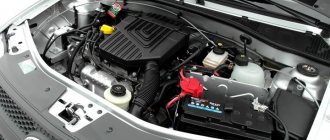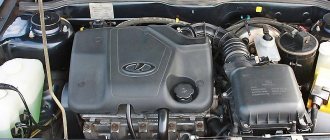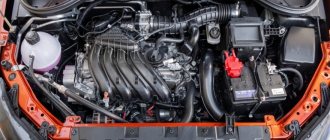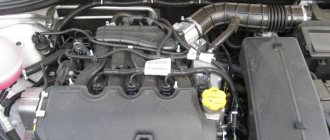Experts consider the VAZ 11186 engine as a modernization of the 21114 engine, a secondary modification of the 21083, or an improvement in the characteristics of the 11183 internal combustion engine. The first option is considered more correct, since the design of 11186 and 21114 is absolutely identical, with the exception of the pistons. The 11186 engine is equipped with AvtoVAZ products, and the previous version of the internal combustion engine was equipped with pistons from the manufacturer Federal Mogul (USA), which developed it under a contract with the Volzhsky Automobile Plant.
ICE 11186 compared to 11183
Characteristics of motor 11186
The project of a “people's car” at a budget price for the average LowCost user was seriously hampered by the economic crisis. For the Lada Granta Standard configuration, the technical characteristics of the existing ICE 11183 were sufficient.
However, for the Norma and Lux trim levels, a more powerful internal combustion engine was needed, so the management of AvtoVAZ, not having sufficient funding for the project of a new engine, came out of the situation as follows:
- the existing version 21114 became the basis for the ICE 11186;
- to reduce costs, pistons from the American manufacturer Federal Mogul were replaced with domestic products of a suitable size;
- The manufacturer changed the engine markings, but no more design changes were made.
Piston 11186 is smaller than 11183
Unlike 11183, the piston of the 11186 motor bends the valve when the timing belt breaks, but the performance characteristics are improved:
| Manufacturer | AvtoVAZ |
| Engine brand | 11186 |
| Years of production | 2011 – … |
| Volume | 1598 cm3 (1.6 l) |
| Power | 64.2 kW (87 hp) |
| Torque moment | 140 Nm (at 3800 rpm) |
| Weight | 140 kg |
| Compression ratio | 10,5 |
| Nutrition | injector |
| Motor type | in-line |
| Injection | electronic multipoint |
| Ignition | the electronic unit |
| Number of cylinders | 4 |
| Location of the first cylinder | TVE |
| Number of valves on each cylinder | 4 |
| Cylinder head material | aluminum alloy |
| Intake manifold | plastic receiver, electronic throttle |
| An exhaust manifold | combined with catalyst |
| Camshaft | from 11183 |
| Cylinder block material | cast iron |
| Cylinder diameter | 82 |
| Pistons | lightweight |
| Crankshaft | ductile iron, oil channels |
| Number of main bearings | 5 |
| Piston stroke | 75.6 mm |
| Fuel | AI-95 |
| Environmental standards | Euro 4 |
| Fuel consumption | highway – 5.7 l/100 km combined cycle 7.3 l/100 km city – 8.5 l/100 km |
| Oil consumption | maximum 1 l/1000 km |
| Engine oil for 11186 | 5W-30 and 10W-30 |
| Engine oil volume | 3.5 l |
| Operating temperature | 95° |
| Motor life | declared 150,000 km actual 300,000 km |
| Adjustment of valves | washers between camshaft cams and tappets |
| Cooling system | forced, antifreeze/antifreeze |
| Coolant quantity | 7.8 l |
| water pump | polymer impeller |
| Candles for 11186 | BPR6ES, A17DVRM |
| Gap between spark plug electrodes | 1.1 mm |
| Timing belt | 163 teeth, pitch 8 mm, belt width 26.7 mm |
| Cylinder operating order | 1-3-4-2 |
| Air filter | Nitto, Knecht, Fram, WIX, Hengst |
| Oil filter | catalog number 90915-10001 replacement 90915-10003, with check valve |
| Flywheel | from 2110, steel crown placed on a cast iron body |
| Flywheel mounting bolts | box MT – M10x1.25 mm, length 26 mm, groove 11 mm box AT – M10x1.25 mm, length 26 mm without groove |
| Valve stem seals | code 90913-02090 inlet light code 90913-02088 exhaust dark |
| Compression | 13 bar |
| XX speed | 650 – 750 min-1 |
| Tightening force of threaded connections | spark plug – 18 Nm flywheel – 62 – 87 Nm clutch bolt – 19 Nm bearing cap – 68 Nm (main) and 53 (rod) cylinder head – three stages 29 Nm, 49 Nm and 90° |
Since the engine does not have hydraulic valve lash compensators, it is practically not important for the user which oil to choose based on the fuel manufacturer. Both domestic and foreign companies are suitable, for example, ZIK, Lukoil, Mobil, Rosneft. On the other hand, relevant information is which oil to pour into the engine based on viscosity:
- for regions of the Russian Federation, the manufacturer recommends all-season oils 10W40, 5W40 and 15W30;
- Synthetic and semi-synthetic lubricants are allowed;
- It is better not to use mineral oil.
To reduce temperature loads on the valves, the engine circuit provides nozzles that inject oil onto their surface. Unlike homemade channels, nozzles fire only when pressure increases, that is, when the lubricant heats up from intense loads. Oil does not enter the crankcase and does not cause increased wear of gaskets in the engine.
Noise level
I switched to this car from the Renault Megane 2. My Renault was equipped with a 1.6-liter engine, a power of 113 horses, and the number of valves was 16.
After it, the Granta engine works like a tractor. Regardless of the car's mileage. Even the engine on the carburetor VAZ-21093 seemed quieter to me.
I specifically compared the noise level on a new Grant with a mileage of 5,000 km and on mine with a mileage of 55,000 km. As it warms up, the sound becomes quieter, but most likely you just get used to it.
Read more about warming up the engine in the article: the need for warming up: myth or fact?
But it is also worth considering that there are no hydraulic compensators, so you will have to adjust the valves. By the way, the engine in the luxury version (98 hp) also rumbles.
Design Features
By default, the 11186 engine retains all the design features of the original 21114, from which it originated:
- volume 1.6 l;
- the block height is 2.3 mm greater than that of 2110;
- crankshaft with an increased crank radius by the same 2.3 mm (piston stroke 75.6 mm, respectively);
- ShPG, flywheel and crown from 2110.
Motor design 11186
In addition, a feature for the 11186 engine is the bending of the valves on the pistons when the timing belt drive breaks:
- the piston skirt is reduced here to make it lighter;
- It is physically impossible to make a deep hole for the valve inside the piston.
Diagram of internal combustion engine components 11186
The manufacturer's manual contains a description of the components and parameters of the internal combustion engine, which are most often compared with the characteristics of the 11183 engine, which has the most similar markings. The main differences between these power drives from the same manufacturer are:
- torque is 15 Nm more;
- power 87 l. With. instead of 82 l. With.;
- motor 11186 has been produced since 2011, and its predecessor 11183 since 2004;
- instead of serial pistons from 2110 weighing 350 g, a lightweight version 21116 weighing 240 g is used;
- connecting rod length increased from 121 mm to 133.32 mm;
- the piston skirt has a graphite coating, the metal in the area of the first ring is anodized;
- combustion chamber 30 cm3 instead of 26 cm3;
- compression ratio increased from 9.6 to 10.5;
- The cylinder head gasket is all-metal, its thickness has been reduced from 1.2 mm to 0.43 mm;
- the cylinder head is 1.2 mm higher to compensate for the enlarged combustion chamber;
- the diameter of the bolts was reduced from M12 to M10 to reduce cylinder deformations during tightening;
- the flow channels in the cylinder head have been increased in diameter, nozzles have been installed to cool the piston heads;
- the working chamfer under the valves is maintained longer due to the strengthening of the aluminum alloy using a special technology;
- since the holes in the pistons are not enough to ensure the safety of the valves, a high-strength timing belt from the Gates manufacturer is used;
- the camshaft V-belt received an automatic tensioner, which had not previously been used in VAZ engines;
- the piston system is protected externally from overheating by a cooling jacket integrated into the cylinder block;
- the length of the receiver channels has been increased, the characteristics of the internal combustion engine are close to those of a 16 valve engine;
- the catalytic collector has a flattened block, which made it possible to separate the ducts and get rid of power losses and turbulence;
- the generator is mounted on a bracket, so its drive belt is not overtightened, like 11183, and lasts longer;
- The cabin heat exchanger and expansion tank are included in the thermostat in parallel, the operating error has decreased to 2 degrees instead of 5 degrees.
Crankcase ventilation
Timing belt cover 11186 on the right, improved design
On the right is the catalytic collector 11186 with a rational exhaust circuit
Modified generator mounting unit
New thermostat design
According to the AvtoVAZ plant, the ICE 11186 has a potential of 120 hp. (without resource reduction) or 180 l. With. (the resource will be reduced due to intensive wear of the piston). The manufacturer recommends tuning exclusively through modifications of components and mechanisms without the use of turbines.
Reliability, weaknesses, maintainability
These three main indicators complement the technical characteristics of the engine in sufficient detail and give a more complete picture of the power unit.
Reliability
VAZ-21114 is one of the few engines with high reliability. Car owners have repeatedly spoken about this on forums. Car service technicians share the same opinion.
For example, the engine of a Lada Kalina 1117 with a mileage of 130 thousand km was inspected. The result was amazing. The pistons are clean, the hone on the cylinder walls is preserved, and there is no carbon deposits on the valves.
The car owner draws attention to the fact that the oil was changed after 7-8 thousand km, and the gasoline for the first 90 thousand km was exclusively AI-95, then it was replaced with AI-92.
Reliability is clearly evidenced by the fact that with a lifespan of 150 thousand km declared by the manufacturer, the engine lasts for more than 300 thousand without repair. And this is not the limit.
The engine has a large margin of safety. With proper tuning, its power can be increased to 180 hp. With. It should be taken into account that such modification of the motor is very complex, expensive and significantly reduces the declared service life.
The reliability of the motor is significantly increased by reducing the maintenance time, using high-quality technical fluids and its reasonable operation.
Weak spots
In general, the VAZ-21114 is considered a successful power unit, but it failed to avoid weak points. According to reviews from car owners and car service workers, the engine has all the VAZ “sores”.
Tendency to overheat. Many have had to deal with this unpleasant phenomenon during operation. The most common cause of overheating is a thermostat and water pump that were not properly adjusted by the manufacturer. If a problem occurs, they will have to be replaced with new ones. There is no other way out of this situation.
Unstable idle speeds cause a lot of trouble. As a rule, they occur when sensors (mass air flow sensor or air flow sensor) fail. Less commonly, due to contamination of fuel supply system elements.
Failed sensors must be replaced. The fuel system needs to be flushed. The malfunction in the first case occurs due to the fault of the plant, and the second falls almost entirely on the shoulders of the car owner.
Refueling with low-quality fuel and untimely maintenance are the main components that cause clogging of the fuel system.
Electrical malfunctions. In this case, the author of the malfunctions is, just like the thermostat and pump, an unfinished ECU (21114-1411020). In addition, the engine often stalls and jerks at idle due to a faulty ignition coil.
Four-terminal ignition coil
The same behavior of the motor can be caused by burnt-out valves if their thermal clearance is not adjusted in a timely manner.
Minor “standard” problems do not bring joy to the car owner, such as oil leaks from under the valve cover, malfunctions of the fuel pump, unauthorized knocking in the engine compartment (usually unadjusted valves knock).
If any malfunction occurs, you must immediately seek help from specialized car service specialists. Timely detection and elimination of the problem in most cases saves the car owner from serious (and therefore costly) engine repairs.
Advantages and disadvantages
The main advantage of the motor is the fact that the manufacturer has already managed to increase the power to 64.2 kW. In addition, it is possible to boost the motor without loss of service life. That is, the owner will not have to make major repairs more often than scheduled.
The disadvantages of ICE 11186 are:
- “meeting” of the piston with the valve in the event of a break in the timing belt drive;
- periodic valve adjustment;
- non-repairable ignition unit.
Adjustment of valves
The advantages of the engine in comparison with the existing versions of the internal combustion engine of the AvtoVAZ manufacturer at the time of its creation are:
- do-it-yourself overhaul after the piston group has reached the end of its service life at least 3 times using different repair kits;
- increased volumes of combustion chambers;
- built-in piston cooling system;
- the hinged one is secured with brackets and has automatic tensioners;
- modernization of the cylinder head and crankshaft;
- piston and crankshaft relief;
- use of parts from existing engines.
Therefore, during repairs and tuning there are no problems with spare parts and components. Maintenance is cheaper than foreign-made engines.
Unqualified maintenance
Insufficient quality of air purification, or, even worse, a break in the air filter curtain will reduce the service life of the motor significantly. A heavily clogged filter will not let dirt through, but neither will air. The motor will operate in an off-design mode, and this will not extend its life.
It is important to follow the replacement intervals prescribed in the instructions. More frequent replacement is needed only in steppes and semi-deserts with their eternal dust. I advise you not to buy the cheapest filters - they can let large particles through. A good thing cannot be too cheap. It is best to buy filters from online spare parts stores.
What cars was it used in?
Created in 2011, the 11186 engine is used as a power drive for several models of the auto manufacturer AvtoVAZ:
- Lada Kalina II – station wagon, sedan;
- Lada Granta (Lux and Norma equipment) – liftback, sedan;
- Lada Priora – sedan, station wagon, hatchback;
- Lada Largus – minivan, station wagon, van;
- Lada Vesta - station wagon;
- Lada XRay is a compact crossover/high hatchback.
Lada XRay
Improved engine characteristics allow it to be used on any front-wheel drive car in the event of a swap rather than engine tuning.
conclusions
Thus, we found out what kind of engines the Grants are equipped with, which are today the most affordable cars from the entire line of cars produced by the Volzhsky Automobile Plant. The difference (including price) between different trim levels is quite large, which causes significant dissatisfaction among car enthusiasts. However, despite this, Granta, including those with 8-stroke engines, is very actively sold in various regions of the country.
Some dealers have exhausted quotas for Granta Test drive Lada Granta Liftback from the newspaper "Arguments and Facts"
The new Lada Granta will be presented in the spring of 2011
Source
Maintenance
In accordance with the manufacturer's regulations, engine 11186 must be serviced in the following order:
| Maintenance object | Time (year) or mileage (1000 km), whichever comes first |
| Timing belt | 3/50 |
| battery | 1/20 |
| Valve clearances | 2/20 |
| Crankcase ventilation | 2/20 |
| Belts that drive attachments | 2/20 |
| Fuel line and tank cap | 2/40 |
| Motor oil | 1/10 |
| Oil filter) | 1/10 |
| Air filter) | 1 – 2/40 |
| Fuel filter) | 4/40 |
| Heating/Cooling Fittings and Hoses | 2/40 |
| coolant | 2/40 |
| Oxygen sensor | 100 |
| Spark plug | 1 – 2/20 |
| Exhaust manifold | 1 |
This is exactly the frequency of maintenance that the ICE 11186 device is designed for.
Expert commentary
Victor Lelikov,
employee :
Spare parts for VAZ engines are in good demand. This is why there is such a high proportion of substandard spare parts on sale. Such parts come from three sources. The first is cooperative spare parts: their use is especially dangerous. For example, the service life of timing belts can be only a few tens of engine hours. The second source is still encountered defects from the official supplier. This is a spare part that did not pass VAZ technical control, but went on sale. Such parts and components destroy buyers’ faith in the reliability of VAZ cars. Finally, the third source is remanufactured engine parts. But these are becoming less and less common.
Malfunctions: causes, elimination
Like all internal combustion engines with mechanical adjustment of valve clearances, the 11186 engine requires periodic adjustment of this characteristic. In addition, during operation, characteristic “diseases” of this particular version of the power drive were identified:
| Bend valves | broken timing belt | periodic wear monitoring |
| Ignition system interruptions | failure of the corresponding block | replacing the ignition module |
| Increased oil consumption | wear of the main bearings, stuck piston rings | replacement of consumables |
| Knock | wear of pistons, bearings | replacement of parts |
When repairing piston and crankshaft engines, it is recommended to use original components from the AvtoVAZ manufacturer. Because only he uses special technologies for strengthening structural materials. From third-party companies, the metal may be “raw”; the resource of such consumables cannot be analyzed.
The ignition module cannot be repaired
How to extend engine life?
Obviously, a Lada car can be treated very differently. For some, this is a “car” for a couple of years - to get by until the difficult times are over. Someone cares and cherishes their new Vesta. But over time, the attitude towards the car becomes less and less reverent.
Those who want to maximize the life of their cars should:
- Change the oil more often than the regulations require, approximately twice as often.
- Use high-quality consumables and components.
- Do not overload the engine. Both frequent acceleration “to the cutoff” and driving with the pedal “to the floor” at low speeds are harmful.
- Operating the machine with a trailer reduces the service life of the engine.
- Monitor the thermal conditions of the engine. Do not give a heavy load to a cold engine and avoid overheating in summer.
Tuning
Initially, the manufacturer builds additional potential into its engines in order to make any changes in future versions. However, the 11186 engine can be upgraded on its own. The following type of tuning is considered standard:
- camshaft - replacement of a standard part with a Nuzhdin 10.93 or Dynamics 108 camshaft;
- cylinder block - boring to 86 - 88 mm (pistons and connecting rods of appropriate sizes will be required);
- intake manifold - zero resistance filter, damper with a diameter of 54 mm, grinding of the internal surfaces of the channels;
- catcollector - replacement with a spider having a 4:2:1 scheme;
- Timing - installation of T-shaped lightweight valves;
- Cylinder head – head milling.
Zero resistance filter
Tuning that adds 30% of power is considered safe (“resource-producing”) for the engine. That is, for 87 hp. With. it will be 29 liters. s., which results in about 115 hp. With. Further tuning becomes dangerous, since the service life will decrease in arithmetic progression. This method is used by athletes, but not by ordinary car enthusiasts.
Thus, the 11186 motor has one significant drawback - it bends the valves. The manufacturer partially corrects the situation through high-life timing belts from Gates. In other respects, the internal combustion engine was superior to its existing counterparts at that time, with the exception of the 21114 engine, which was taken as the basis.
If you have any questions, leave them in the comments below the article. We or our visitors will be happy to answer them
Useful video
You can get additional interesting information about the internal combustion engine of the VAZ 2114 by watching the video below:
It has long been known that each internal combustion engine has its own “safety margin”. It is also no secret that foreign car engines have a longer service life than products of the domestic automobile industry. This is due to the better quality of parts, more modern technologies in their manufacture, as well as the accuracy of assembly and tuning of the internal combustion engine.
If we talk about VAZ engines of different generations, it is worth noting that there is no exact data, that is, in each case, the mileage before overhaul can vary greatly. Next, we will look at how long such engines last on average, as well as what affects the service life of these power units.
Read in this article











